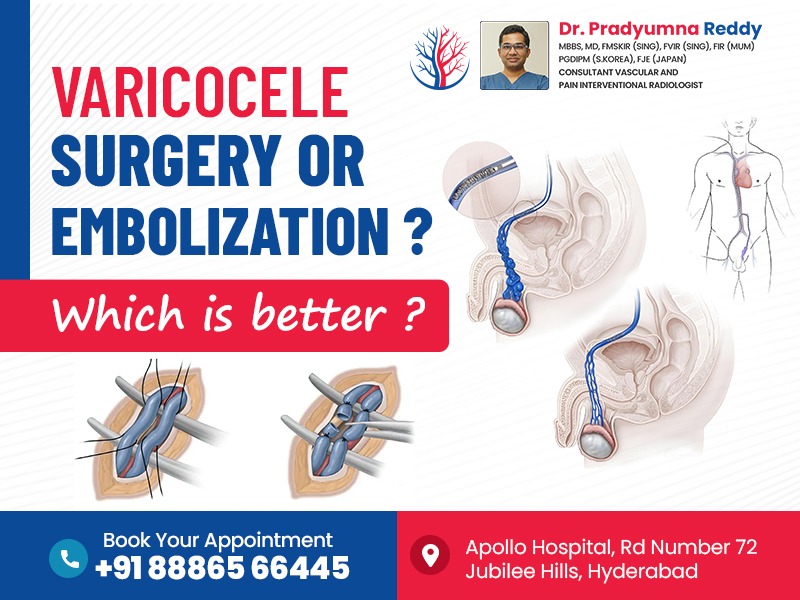Varicocele is a condition that occurs in men. This condition affects the scrotum, and it enlarges the veins inside the scrotum. The veins are responsible for transporting blood from and to the testicles. If the blood is not circulated well due to compressed or damaged veins, blood gets pooled in the veins and veins become enlarged. This condition can even shrink the testicles and can affect sperm production and motility.
However, this condition can be corrected using surgery. Varicocele surgery has been in use for several years and it is effective at treating varicocele. But a new procedure called varicocele embolization has become popular in recent times. It is important to know the difference between them so that you can choose the right one for you.
Treatment Options for Varicocele
Varicocele condition can be treated using two ways namely surgery and a non-invasive procedure called embolization.
The surgical options include the following:
- Open surgery: To perform open surgery, the doctor may use either general or local anesthesia. A small incision will be made at the scrotum, groin or lower abdomen. The doctor further uses a microscope and ultrasound tests to view the area to be treated.
- Micro Varicocelectomy: It is a complex procedure that removes the swollen veins in the scrotum. It makes use of a high-power microscope to identify the exact veins. Though the procedure is complex, it has less complications than open surgery. It is performed under local anesthesia.
- Laparoscopic surgery: It is performed by making a small incision in the abdomen and by using special instruments to view the inside of the body. Gas is filled in the abdomen so that the doctor can easily view and perform the procedure. This type of surgery has a risk of developing complications and it requires general anesthesia.
Embolization – Minimally Invasive Procedure: It is a minimally invasive procedure and it is performed under local anesthesia. This procedure is performed by an interventional radiologist who specializes in treating conditions using special tools and imaging techniques. During the procedure, a thin tube is inserted into the vein in the groin or neck. You may be given local anesthesia and a sedative to ease your discomfort during insertion. Now, using imaging such as an X-ray on the monitor, the radiologist directs the catheter towards the site to be treated. The radiologist then releases coils or a solution to block the damaged vein. Due to this, the blood flow to that damaged vein gets blocked and the blood flow will be redirected to other healthy veins.
Comparing Varicocele Surgery and Embolization
There are differences between varicocele surgery and embolization in terms of recovery, hospital stay, success rate, etc. Let us understand them in detail:
- Anesthesia: Both open surgery and microsurgery requires either general or local anesthesia. Whereas laparoscopic surgery requires general anesthesia. The embolization procedure requires local anesthesia with mild sedation.
- Recovery: The recovery from surgery takes around 2 to 3 weeks and the doctor might prescribe medications to relieve your pain and discomfort after the procedure. You can resume exercises two weeks after surgery. You can resume your sexual activities after 4 weeks of surgery. On the other hand, the recovery from embolization is very short and it is 2 or 3 days. You can start your physical activity after a week of embolization. You can resume sexual activity after 1 or 2 weeks of embolization.
- Success rate: With varicocele surgery, one out of 10 men may experience the reoccurrence of varicocele. Microsurgery is the most effective one of all the surgical options. Embolization has a 90% success rate and it offers long-term results.
- Scarring: Surgery can cause some scarring as incisions are made during surgery. Embolization does not cause any scarring as no incisions are made.
- Possible risks: Surgery can pose risks such as infection, reoccurrence of varicocele, and artery damage. But embolization has fewer to no risks and the pain is also temporary.
What are the Benefits of Undergoing Treatment for Varicocele?
Earlier, there was no hope for treating varicocele. But treating varicocele and reducing the pain have multiple choices now. Whether you choose surgery or embolization for varicocele treatment, it can relieve your pain and discomfort. The treatment also brings your testicles to their normal size, and improves the quality and quantity of sperm.
The advancements in technology have brought alternatives to surgery that offer similar results. If you are diagnosed with varicocele, embolization can be the right choice due to its benefits. But you should check with your doctor if you can undergo embolization.
Looking for Varicocele Treatment in Hyderabad? Meet Dr Pradyumna Reddy Today
If you have been diagnosed with varicocele and looking for the best possible treatment, speak to Dr Pradyumna Reddy. He has been working as an interventional radiologist in Hyderabad for over 6 years and has mastered in several radiology procedures. He aims at treating the condition using personalized treatment methods. To discuss your condition, call us and schedule an appointment today.






